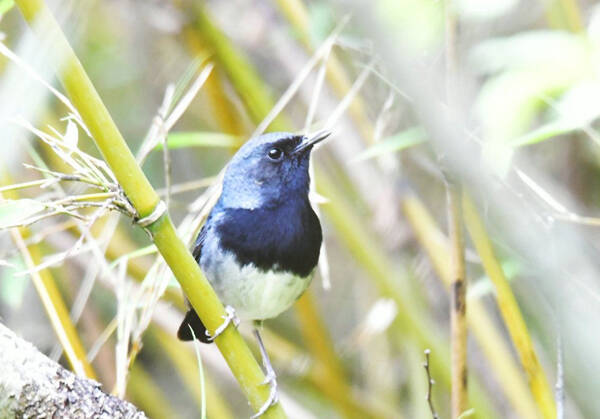Luscinia obscura
IUCN
LCBasic Information
Scientific classification
- name:Luscinia obscura
- Scientific Name:Luscinia obscura,Calliope obscura,Black-throated Robin,Blackthroat,nightingale
- Outline:Songbird
- Family:Passeriformes Flycatchers S.Robin
Vital signs
- length:About 12.7 cm
- Weight:15-20g
- lifetime:No verification information
Feature
No verification information
Distribution and Habitat
Distributed in northern Thailand and China.
In China, it is distributed in a small area adjacent to the three provinces of southern Shaanxi, southeastern Gansu, and central and northern Sichuan. It has been seen in southeastern Yunnan and northern Thailand during migration.
In Gansu, China, the habitat of the black-throated robin is 3050-3350 meters above sea level; in Sichuan, the habitat is a large dense bamboo forest at an altitude of 2400-2500 meters. In Thailand, the species is active at an altitude of 400 meters during the non-breeding season. The black-throated robin lives in broad-leaved forest shrubs or coniferous forests and bamboo groves. When wintering in northern Thailand, it is seen among bamboo groves and grass, and there are also a few shrubs and trees scattered on the vegetation.
Appearance
Male: Upper body dark slate grey, tail coverts shiny black. Eyes, head and sides of neck, throat and chest dark black, sides of body grey, center of abdomen milky white with yellow stains, thickest on flanks, lower tail coverts edge grey, wings and center tail feathers black, other tail feathers 2/3 white at base, 1/3 black at tip.
Female: Upper body dark olive brown, tail coverts and flight feathers edge light yellow brown, lower body light olive brown, center of abdomen stained with yellowish brown, other lower body pure white.
Details
Blackthroat, foreign name Blackthroat, no subspecies.

Regarding the taxonomic status of the black-throated robin, previous scholars such as Goodwin and Vaurie (1956), Zheng Zuoxin (1958), and Vaurie (1959) all believed that the black-throated robin was just a different color form of the golden-breasted robin. Ripley (in Mayrand Paynter, 1964) divided the black-throated and golden-breasted robins into two independent species. The distribution ranges of these two robins are very different, so he agreed with this approach. However, due to the limited specimens, the information on young birds, sub-adult birds and life history is also lacking. Therefore, whether the black-throated robins and golden-breasted robins are two independent species or just two different color forms of a single species can only be determined after more specimens are obtained.
The food of the black-throated robins is mainly lepidoptera and diptera larvae.
The black-throated robins occasionally sing in the spring, during the brooding period or during migration. They can sing at night and are commonly known as nightingales, but they mainly sing after the sun rises during the day. The call is relatively simple, repeated after a short interval, drreee-drreee drreee-drreee drreeedreee huti-huti huti-huti huti-huti. There are also more ambiguous and high-pitched sounds, duriiii'hutu, drrii'hitu, drrrii'huti-huti-huti and some short trills and simple trills. The call is often mixed with low weak single or double tuc sounds.
After the black-throated thrush migrates to the breeding ground, the male bird will sing in the dense bamboo forest to establish its territory. The female bird moves deep in the bamboo forest and rarely sings. The male bird mainly moves within a hundred meters of the nest area, and there is almost no overlap in the activity range of individual male birds.
The forest type of the Black-throated Robin nest site is a mixed coniferous and broad-leaved forest, with dense Qinling arrow bamboo growing under the forest. The nests are all built in natural earth caves at the edge of the forest. The nest caves are located on a small steep slope at a certain height from the ground. The slopes of the two nest sites are 45° east-southeast and 80° east-southeast, with slopes of 85° and 75° respectively. The cave entrances are both facing 45° east-southeast, and the heights of the cave entrances from the ground are 55 cm and 80 cm respectively. The nests are close to the water source and the edge of the forest, with low tree density and low shrub coverage. There are herbaceous plants growing around the cave entrance, and the fallen leaf coverage is high. In addition, the cave entrance is perpendicular to the ground and slightly tilted upward, and the cave is basically horizontal.
The nests were built in the cave, 4.8 cm and 5.2 cm away from the cave entrance. The nest entrance was cup-shaped and woven with bamboo leaves, dead grass, moss, etc. There was no bedding inside the nest, and the bottom of the nest was covered with dead leaves, hay, etc.
The brooding period of the black-throated thrush is 11 days. The brooding behavior mainly includes warming the chicks, feeding and cleaning feces. The chick warming behavior is only completed by the female bird, while the feeding and feces cleaning behaviors are completed by both male and female parents. When cleaning feces, the parents will take away the feces of the chicks, and sometimes swallow them directly. During the period of raising chicks, the black-throated robin is alert. When feeding chicks, it does not directly enter the nest, but turns back and observes in the dense bamboo forest. After confirming safety, it quickly flies into the cave entrance. Sometimes it also lands on the ground a little far away from the nest and rushes into the cave horizontally from the grass on the side of the nest.
Listed in the IUCN Red List of Threatened Species in 2016 ver 3.1-Vulnerable (VU).
Listed in the Birdlife International World Threatened Bird List.
Listed in the "National List of Terrestrial Wildlife with Important Economic and Scientific Research Value" issued by the State Forestry Administration of China on August 1, 2000.
Listed in the "China Red List of Biodiversity" - Endangered (EN).
Listed in the "China Red List of Species" - Vulnerable (VU).
Listed in the second level of the "List of National Key Protected Wildlife in China".
Protect wild animals and stop eating game.
Maintaining ecological balance is everyone's responsibility!








